View in other NatureServe Network Field Guides
NatureServe
Montana
Utah
Wyoming
Idaho
Wisconsin
British Columbia
South Carolina
Yukon
California
New York
Sodaville Milkvetch - Astragalus lentiginosus var. salinus
Native Species
Global Rank:
G5T5
State Rank:
S3S5
(see State Rank Reason below)
C-value:
Agency Status
USFWS:
USFS:
BLM:
External Links
State Rank Reason (see State Rank above)
In Montana Astragalus lentiginosus is represented by only variety salinus. Astragalus lentiginosus var. salinus occurs in Beaverhead County, Montana on the eastern edge of its range. Plants grow in sagebrush steppe habitat in both disturbed and undisturbed settings. Although it is restricted to a small portion of Montana, plants appear relatively common, even a little weedy in places, and its habitat does not seem limited or threatened.
- Details on Status Ranking and Review
Range Extent
ScoreD - 1,000-5,000 sq km (~400-2,000 sq mi)
Comment3,921 square kilometers for 25 observations.
Area of Occupancy
ScoreD - 6-25 4-km2 grid cells
CommentMontana can be divided into 30,390 4x4 square kilometer cells. For this species plant observations occur in 21 of these 4x4 square kilometer cells.
Number of Populations
ScoreC - 21 - 80
Comment25 observations: 5 (1895-1952), 22 (1983-2011)
Number of Occurrences or Percent Area with Good Viability / Ecological Integrity
ScoreC - Few (4-12) occurrences with excellent or good viability or ecological integrity
Comment4 observations assumed to be of good viability based on descriptors of 'common' or 'locally common'.
Environmental Specificity
ScoreC - Moderate. Generalist or community with some key requirements scarce
CommentCoefficient of Conservatism value is 4 indicating it has a intermediate ecological tolerance and can persist, but not thrive with some disturbance.
Threats
ScoreD - Low
CommentThreats have not been identified.
General Description
PLANTS: Perennial forbs that grow from a branched caudex. Plants range from being almost hairless to sparsely strigose (straight, appressed hairs that point in the same direction). Stems are prostrate to ascending, 10–40 cm. Source: Lesica et al. 2012.
LEAVES: Alternately arranged on the stem and pinnately divided. Each leave having 11 to 19 obovate leaflets. Leaflets are 5–15 mm long with blunt to emarginate tips. Stipules at the base of the leaf's stem are lanceolate, 2–3 mm long. Source: Lesica et al. 2012.
INFLORESCENCE: Bracteate racemes of yellowish-white, papilionaceous flowers grow terminal on the stem and in leaf axils; inflorescence is shorter than the leaves. Racemes are dense with 10–25 flowers, each spreading or ascending. Flower petals are ochroleucus, rarely purple-tipped. Banner petal is 8–13 mm long, slightly reflexed. Keel petal is 6–8 mm long. The calyx has white-strigose hairs; each sepal is 1–2 mm long. Fruit is a legume that spreads, is glabrous, ovoid, 15–20 mm long, and has a flattened beak of 3–5 mm long. Source: Lesica et al. 2012.
VARIETY salinus: Calyx 4-6.5 mm long. Corolla 7.5-11 mm long. Legume body is roundish to ovoid, bladdery-inflated, papery, generally translucent, and primarily straight. Source: Giblin et al. [eds.] 2018.
Diagnostic Characteristics
Montana's plants belong to variety salinus and have only been documented in Beaverhead County.
Two other varieties are found in our neighboring states.
Variety salinus
* Calyx: 4-6.5 mm long.
* Corolla: 7.5-11 mm long.
* Legume: Body is roundish to ovoid, bladdery-inflated, papery, generally translucent, and primarily straight.
Variety platyphyllidius
* Calyx: 8-12.5 mm long.
* Corolla: 13-20 mm long.
* Legume: Body is ovoid to lanceoloid, at least twice as long as wide, coriaceous, and often curved.
* Nearest populations: southern Idaho and Wyoming.
Variety lentiginosus
* Calyx: 4-6.5 mm long.
* Corolla: 7.5-11 mm long.
* Legume: Body is roundish to ovoid, often inflated, stiffly papery to coriaceous, opaque, and straight or curved.
* Nearest populations: southern Idaho.
Source: Giblin et al. [eds.] 2018.
Species Range
Montana Range
Range Descriptions
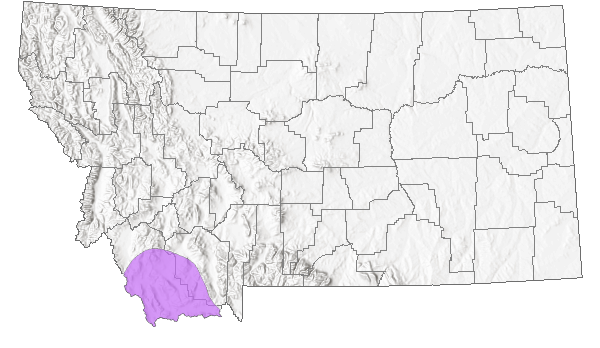
 Native
Native
Range Comments
Central Oregon to northeastern California, east to east-central Idaho, southwest Montana, Wyoming, and Utah (Giblin et al. [eds.] 2018).
Observations in Montana Natural Heritage Program Database
Number of Observations: 25
(Click on the following maps and charts to see full sized version)
Map Help and Descriptions
Relative Density
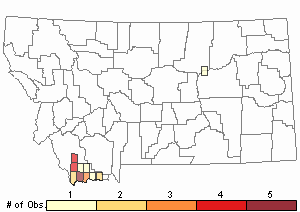
Recency
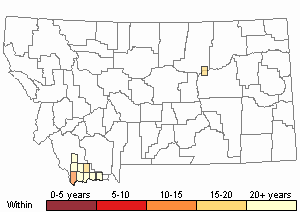
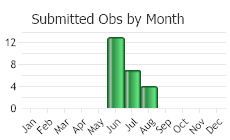
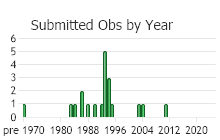
 (Observations spanning multiple months or years are excluded from time charts)
(Observations spanning multiple months or years are excluded from time charts)
Habitat
Often silty soil in sagebrush steppe within valleys of Montana (Lesica et al. 2012).
Ecology
POLLINATORSThe following animal species have been reported as pollinators of this plant species or its genus where their geographic ranges overlap:
Bombus vagans,
Bombus appositus,
Bombus auricomus,
Bombus bifarius,
Bombus borealis,
Bombus centralis,
Bombus fervidus,
Bombus flavifrons,
Bombus huntii,
Bombus mixtus,
Bombus nevadensis,
Bombus rufocinctus,
Bombus ternarius,
Bombus terricola,
Bombus occidentalis,
Bombus pensylvanicus,
Bombus griseocollis, and
Bombus insularis (Macior 1974, Thorp et al. 1983, Mayer et al. 2000, Colla and Dumesh 2010, Wilson et al. 2010, Koch et al. 2012, Miller-Struttmann and Galen 2014, Williams et al. 2014).
Reproductive Characteristics
Plants reproduce by seed.
PAPILIONACEOUS FLOWER
*Species belonging to the Pea Subfamily (Papilionoideae) have papilionaceous flowers (Elpel 1998). This applies to almost all species in the northern latitudes (Elpel 1998).
*It refers to the petals of the flowers appearing like a butterfly.
*The 5 petals (collectively called the corolla) have a bilateral symmetry: large upper petal (banner), two lateral petals (wings), and usually two fused lower petals (keeled). The keel petals resembling a boat.
Stewardship Responsibility
Threats or Limiting Factors
Astragalus lentignosus var. salinus has no identified threats in Montana.
References
- Literature Cited AboveLegend:
 View Online Publication
View Online Publication Colla, S.R. and S. Dumesh. 2010. The bumble bees of southern Ontario: notes on natural history and distribution. Journal of the Entomological Society of Ontario 141:39-68.
Colla, S.R. and S. Dumesh. 2010. The bumble bees of southern Ontario: notes on natural history and distribution. Journal of the Entomological Society of Ontario 141:39-68. Hitchcock, C.L. and A. Cronquist. 2018. Flora of the Pacific Northwest: An Illustrated Manual. Second Edition. Giblin, D.E., B.S. Legler, P.F. Zika, and R.G. Olmstead (eds). Seattle, WA: University of Washington Press in Association with Burke Museum of Natural History and Culture. 882 p.
Hitchcock, C.L. and A. Cronquist. 2018. Flora of the Pacific Northwest: An Illustrated Manual. Second Edition. Giblin, D.E., B.S. Legler, P.F. Zika, and R.G. Olmstead (eds). Seattle, WA: University of Washington Press in Association with Burke Museum of Natural History and Culture. 882 p. Koch, J., J. Strange, and P. Williams. 2012. Bumble bees of the western United States. Washington, DC: USDA Forest Service, Pollinator Partnership. 143 p.
Koch, J., J. Strange, and P. Williams. 2012. Bumble bees of the western United States. Washington, DC: USDA Forest Service, Pollinator Partnership. 143 p. Lesica, P., M.T. Lavin, and P.F. Stickney. 2012. Manual of Montana Vascular Plants. Fort Worth, TX: BRIT Press. viii + 771 p.
Lesica, P., M.T. Lavin, and P.F. Stickney. 2012. Manual of Montana Vascular Plants. Fort Worth, TX: BRIT Press. viii + 771 p. Macior, L.M. 1974. Pollination ecology of the Front Range of the Colorado Rocky Mountains. Melanderia 15: 1-59.
Macior, L.M. 1974. Pollination ecology of the Front Range of the Colorado Rocky Mountains. Melanderia 15: 1-59. Mayer, D.F., E.R. Miliczky, B.F. Finnigan, and C.A. Johnson. 2000. The bee fauna (Hymenoptera: Apoidea) of southeastern Washington. Journal of the Entomological Society of British Columbia 97: 25-31.
Mayer, D.F., E.R. Miliczky, B.F. Finnigan, and C.A. Johnson. 2000. The bee fauna (Hymenoptera: Apoidea) of southeastern Washington. Journal of the Entomological Society of British Columbia 97: 25-31. Miller-Struttmann, N.E. and C. Galen. 2014. High-altitude multi-taskers: bumble bee food plant use broadens along an altitudinal productivity gradient. Oecologia 176:1033-1045.
Miller-Struttmann, N.E. and C. Galen. 2014. High-altitude multi-taskers: bumble bee food plant use broadens along an altitudinal productivity gradient. Oecologia 176:1033-1045. Thorp, R.W., D.S. Horning, and L.L. Dunning. 1983. Bumble bees and cuckoo bumble bees of California (Hymenoptera: Apidae). Bulletin of the California Insect Survey 23:1-79.
Thorp, R.W., D.S. Horning, and L.L. Dunning. 1983. Bumble bees and cuckoo bumble bees of California (Hymenoptera: Apidae). Bulletin of the California Insect Survey 23:1-79. Williams, P., R. Thorp, L. Richardson, and S. Colla. 2014. Bumble Bees of North America. Princeton, NJ: Princeton University Press. 208 p.
Williams, P., R. Thorp, L. Richardson, and S. Colla. 2014. Bumble Bees of North America. Princeton, NJ: Princeton University Press. 208 p. Wilson, J.S., L.E. Wilson, L.D. Loftis, and T. Griswold. 2010. The montane bee fauna of north central Washington, USA, with floral associations. Western North American Naturalist 70(2): 198-207.
Wilson, J.S., L.E. Wilson, L.D. Loftis, and T. Griswold. 2010. The montane bee fauna of north central Washington, USA, with floral associations. Western North American Naturalist 70(2): 198-207.
- Additional ReferencesLegend:
 View Online Publication
View Online Publication
Do you know of a citation we're missing? Culver, D.R. 1993. Sensitive plant species inventory in the Centennial Valley, Beaverhead County, Montana. Unpublished report to the Butte District, Bureau of Land Management. Montana Natural Heritage Program, Helena, 42 pp. plus appendices.
Culver, D.R. 1993. Sensitive plant species inventory in the Centennial Valley, Beaverhead County, Montana. Unpublished report to the Butte District, Bureau of Land Management. Montana Natural Heritage Program, Helena, 42 pp. plus appendices. Culver, D.R. 1994. Floristic analysis of the Centennial Region, Montana. M.Sc. Thesis. Montana State University, Bozeman. 199 pp.
Culver, D.R. 1994. Floristic analysis of the Centennial Region, Montana. M.Sc. Thesis. Montana State University, Bozeman. 199 pp. Lesica, P., M.T. Lavin, and P.F. Stickney. 2022. Manual of Montana Vascular Plants, Second Edition. Fort Worth, TX: BRIT Press. viii + 779 p.
Lesica, P., M.T. Lavin, and P.F. Stickney. 2022. Manual of Montana Vascular Plants, Second Edition. Fort Worth, TX: BRIT Press. viii + 779 p. Quire, R.L. 2013. The sagebrush steppe of Montana and southeastern Idaho shows evidence of high native plant diversity, stability, and resistance to the detrimental effects of nonnative plant species. M.Sc. Thesis. Bozeman, MT: Montana State University. 124 p.
Quire, R.L. 2013. The sagebrush steppe of Montana and southeastern Idaho shows evidence of high native plant diversity, stability, and resistance to the detrimental effects of nonnative plant species. M.Sc. Thesis. Bozeman, MT: Montana State University. 124 p. Vanderhorst, J.P. and P. Lesica. 1995a. Sensitive plant survey of the Tendoy Mountains in the Beaverhead National Forest, Beaverhead County, Montana. Unpublished report to the Bureau of Land Management, Butte District. Montana Natural Heritage Program, Helena, MT. 59 pp. plus appendices.
Vanderhorst, J.P. and P. Lesica. 1995a. Sensitive plant survey of the Tendoy Mountains in the Beaverhead National Forest, Beaverhead County, Montana. Unpublished report to the Bureau of Land Management, Butte District. Montana Natural Heritage Program, Helena, MT. 59 pp. plus appendices.
- Web Search Engines for Articles on "Sodaville Milkvetch"





